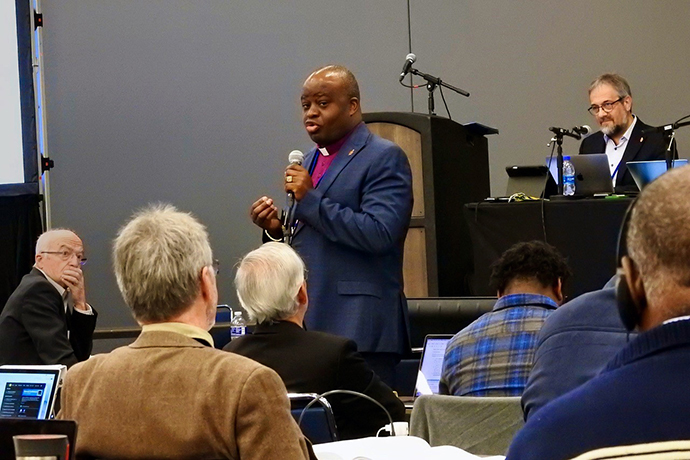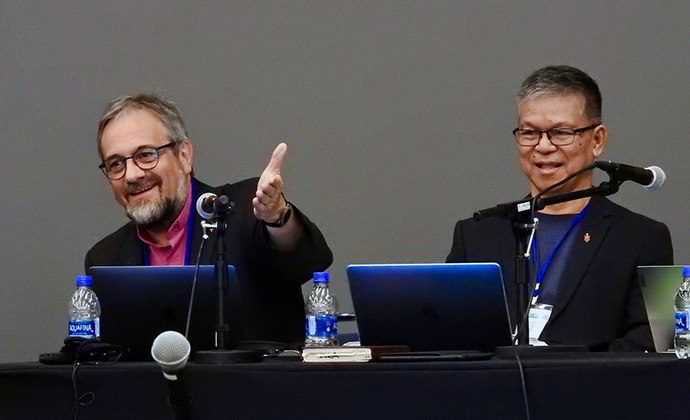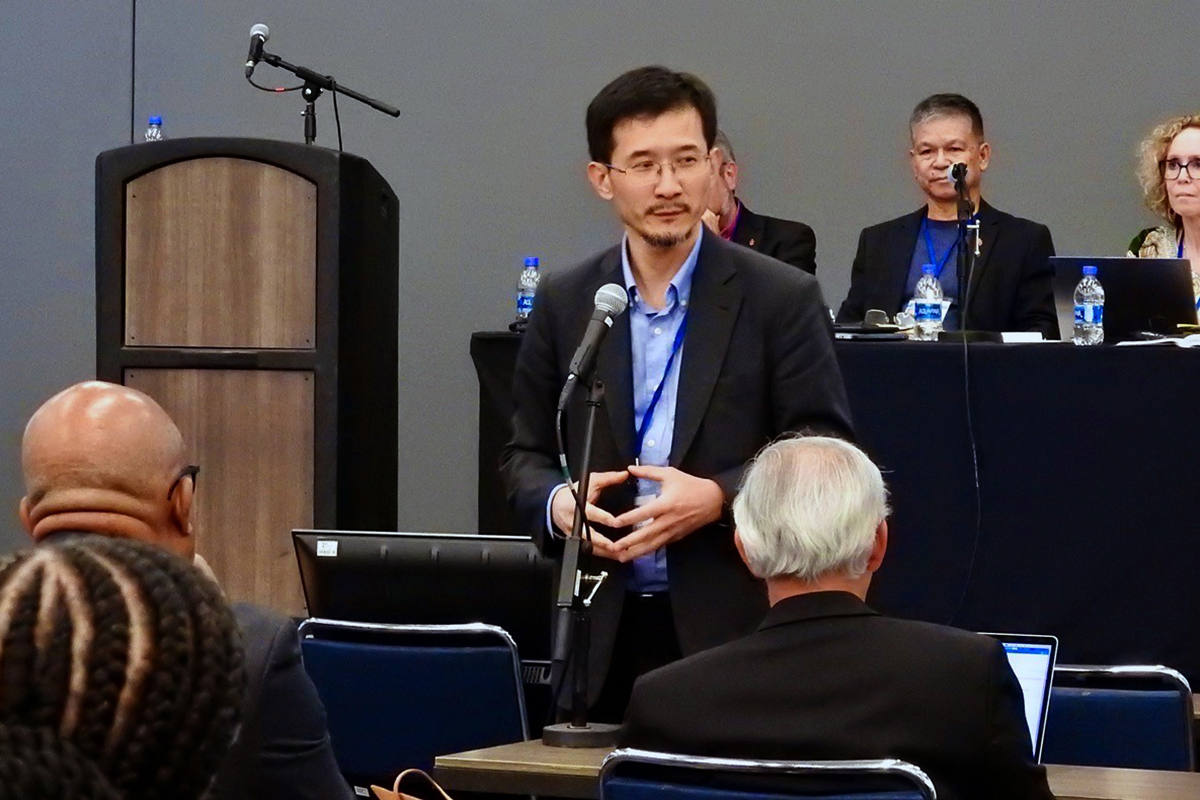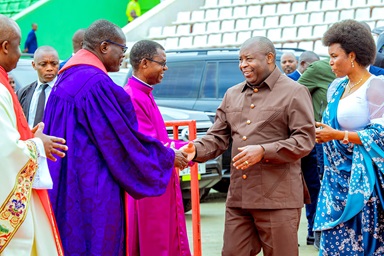Key facts
- The Standing Committee on Central Conference Matters met just ahead of General Conference.
- Committee members advanced petitions dealing with regionalization and the desire by Eurasian conferences to become autonomous.
- They also sent on to General Conference petitions dealing with the number of bishops in Africa and the number and naming of African central conferences.
Legislation to put the different geographical regions of The United Methodist Church on equal footing has crossed a significant threshold.
Meeting just ahead of General Conference, the Standing Committee on Central Conference Matters advanced five petitions representing the bulk of proposed worldwide regionalization. That means the petitions have cleared the first hurdle faced by all legislation at General Conference — making it out of committee.
General Conference — The United Methodist Church’s top lawmaking assembly — runs from April 23 to May 3. Its delegates meeting in plenary will make the final decisions on all petitions approved by the standing committee.
The standing committee also moved forward petitions recommending the number of bishops in Africa, the number and naming of African central conferences and autonomy for four Eurasian annual conferences.
The regionalization petitions advanced by the standing committee could go before the full plenary as early as this week.

German Central Conference Bishop Harald Rückert congratulated standing committee members for methodically and congenially working through a full queue of petitions on April 21-22.
“We did accomplish a lot of good work,” said Rückert, who presided over most of the committee sessions, held in the same Charlotte Convention Center where General Conference will meet over the next 10 days.
The standing committee is a permanent committee of General Conference and during the lawmaking assembly acts as a legislative committee. It deals with matters in central conferences — church regions in Africa, the Philippines and Europe. Most committee members are from those areas.
Regionalization is expected to be a major focus at this General Conference, and the standing committee easily advanced a handful of petitions related to that.
Under regionalization, the seven current central conferences and the U.S. would become regional conferences, with the same authority to pass legislation for greater missional impact.
Regionalization represents an effort to put the church’s different geographical regions on equal footing — and to make General Conference less U.S.-centric.
Currently, The United Methodist Church’s constitution gives central conferences authority to make “such changes and adaptations” to the Book of Discipline — the denomination’s policy book — as missional needs and differing legal contexts require. But no such body exists to deal with matters solely related to the U.S., like U.S. clergy retirement benefits.
The Connectional Table, a leadership body that acts as sort of a denomination-wide church council, initially prepared legislation to create such a U.S. regional conference. That effort was then picked up and expanded by a grassroots group of central conference leaders who drafted the Christmas Covenant.
The standing committee built on the work of both the Connectional Table and Christmas Covenant to create the eight petitions that make up Worldwide Regionalization. The Connectional Table and most Christmas Covenant team members have since endorsed the Worldwide Regionalization.
The five Worldwide Regionalization petitions advancing to the plenary require amending the denomination’s constitution to take effect. That’s a high bar.
Ratification requires at least a two-thirds vote at General Conference and at least a two-thirds aggregate vote by the denomination’s annual conferences — bodies consisting of lay and clergy voters from multiple congregations.
However, Rückert said during the committee’s Charlotte meeting that the different groups working together on regionalization gave him hope.
“To me it’s a strong signal for the future of our church to do collaborative work rather than strategize against each other,” he said. “I am very grateful for that.”

Africa is a growth region for The United Methodist Church, and the committee dealt with how many active bishops the continent should have.
The 2016 General Conference approved that the standing committee work toward adding five more bishops — raising the number from 13 to 18. But since then, the denomination has endured a pandemic and wave of local church disaffiliations in the U.S., where nearly all financial support comes for the Episcopal Fund and other funds supporting general church operations.
As expected, the standing committee sent on to General Conference a petition that would add two bishops — with the hope that three others would be phased in as circumstances allow.
“The finances of the church have changed in a dramatic way,” said the Rev. Amy Lippoldt, a committee member and part of a task force that revisited the question of adding bishops in Africa. “It would be more prudent to go slower on the implementation of these bishops.”
The petition approved by the committee would see Africa go from 13 to 15 bishops, adding one in the present Congo Central Conference and one in the present Africa Central Conference.
The committee sent on to General Conference another petition that would add a central conference in Africa, bringing the number to four.
The same petition would rename the present Congo Central Conference the “Central Africa Central Conference.” It would consist of United Methodist churches in the Central African Republic, Democratic Republic of Congo, Republic of Congo, Tanzania and Zambia, and would have five bishops.
Part of the present Africa Central Conference would become the new “East Africa Central Conference,” consisting of Burundi, Ethiopia, Kenya, Rwanda, South Sudan and Uganda — with two bishops.
The other part would become the “Southern Africa Central Conference,” consisting of Angola, Botswana, Malawi, Mozambique, Namibia, Swaziland, South Africa and Zimbabwe — with four bishops.
The West Africa Central Conference would not have a name change, and would consist of Burkina Faso, Cameroon, Côte d’Ivoire, Guinea, Guinea-Bissau, Liberia, Mali, Niger, Nigeria, Senegal and Sierra Leone — with four bishops.
Much of the standing committee’s work focused on trying to strengthen the various geographical regions of the denomination. However, the committee also took time to prepare for the departure of one of those regions.
Early in its Charlotte deliberations, the committee nearly overwhelmingly approved a petition enabling four Eurasian annual conferences to leave The United Methodist Church.
The four conferences had submitted to the committee a constitution and main doctrinal standards for a new, autonomous church to be called The Christian Methodist Church in Eurasia.
The planned departure has long been in the works and owes, in part, to the predominant traditionalist theology in those areas and tensions with other annual conferences in the Northern Europe and Eurasia Central Conference.
The conferences plan to leave under Paragraph 572 of the United Methodist Book of Discipline, which deals with conferences outside the U.S. that want to become autonomous.
Assuming General Conference delegates go along with the standing committee’s decision, the new status for the Eurasian conferences would become effective early next year at a session of the Northern Europe and Eurasia Conference.
Subscribe to our
e-newsletter
Bishop Eduard Khegay leads the Eurasia Episcopal Area and has signaled his own intention to leave The United Methodist Church. He spoke to the committee after its vote to approve the enabling petition.
“This is for us like leaving home,” Khegay said. “My hope is we can keep the friendships and relationships whenever it’s possible. … We want to remain your sisters and brothers.”
Khegay requested that the plenary vote on autonomy for the Eurasian conferences come early in the General Conference, and Rückert said that is likely.
“We feel both the pain of leaving and also the grace of the way this could happen,” Rückert said, noting that a sub-group of the standing committee had a key role in working with the Eurasian conferences as they sought autonomy.
The standing committee rejected a petition that would create a new disaffiliation path for annual conferences in the central conferences. The sponsor, the Rev. Julius Nelson of the Liberia Conference, was allowed to speak to the committee but the vote went solidly against his petition. Various other disaffiliation-related petitions — creating exit paths for local churches or annual conferences — are yet to be considered by legislative committees.
In another noteworthy move, the standing committee approved a petition to create a Central Conference Higher Education Fund, separate from the current Central Conference Theological Fund, which is more focused on clergy.
The new fund would have $5 million from 2025 to 2028 to strengthen Methodist-related schools outside the U.S., including through scholarships.
“You have done an action that is going to be very impactful for the years to come,” North Katanga Area Bishop Mande Muyombo told fellow standing committee members.
Hodges is a Dallas-based writer for United Methodist News. Contact him at 615-742-5470 or [email protected]. To read more United Methodist news, subscribe to the free Daily or Weekly Digests.




